spare wheel CADILLAC SEVILLE 2004 5.G Owners Manual
[x] Cancel search | Manufacturer: CADILLAC, Model Year: 2004, Model line: SEVILLE, Model: CADILLAC SEVILLE 2004 5.GPages: 410, PDF Size: 2.64 MB
Page 262 of 410
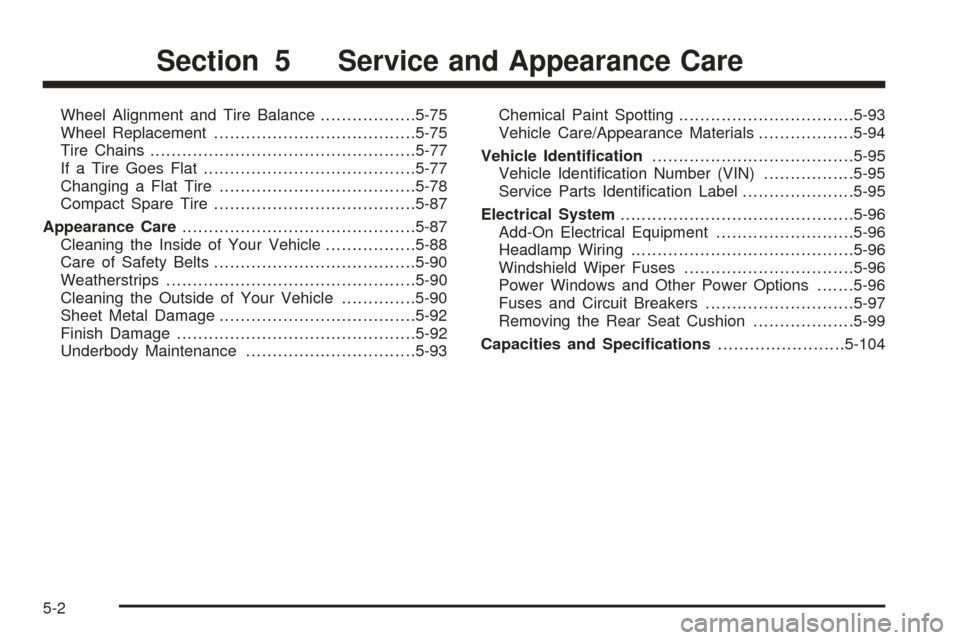
Wheel Alignment and Tire Balance..................5-75
Wheel Replacement......................................5-75
Tire Chains..................................................5-77
If a Tire Goes Flat........................................5-77
Changing a Flat Tire.....................................5-78
Compact Spare Tire......................................5-87
Appearance Care............................................5-87
Cleaning the Inside of Your Vehicle.................5-88
Care of Safety Belts......................................5-90
Weatherstrips...............................................5-90
Cleaning the Outside of Your Vehicle..............5-90
Sheet Metal Damage.....................................5-92
Finish Damage.............................................5-92
Underbody Maintenance................................5-93Chemical Paint Spotting.................................5-93
Vehicle Care/Appearance Materials..................5-94
Vehicle Identification......................................5-95
Vehicle Identification Number (VIN).................5-95
Service Parts Identification Label.....................5-95
Electrical System............................................5-96
Add-On Electrical Equipment..........................5-96
Headlamp Wiring..........................................5-96
Windshield Wiper Fuses................................5-96
Power Windows and Other Power Options.......5-96
Fuses and Circuit Breakers............................5-97
Removing the Rear Seat Cushion...................5-99
Capacities and Specifications........................5-104
Section 5 Service and Appearance Care
5-2
Page 331 of 410
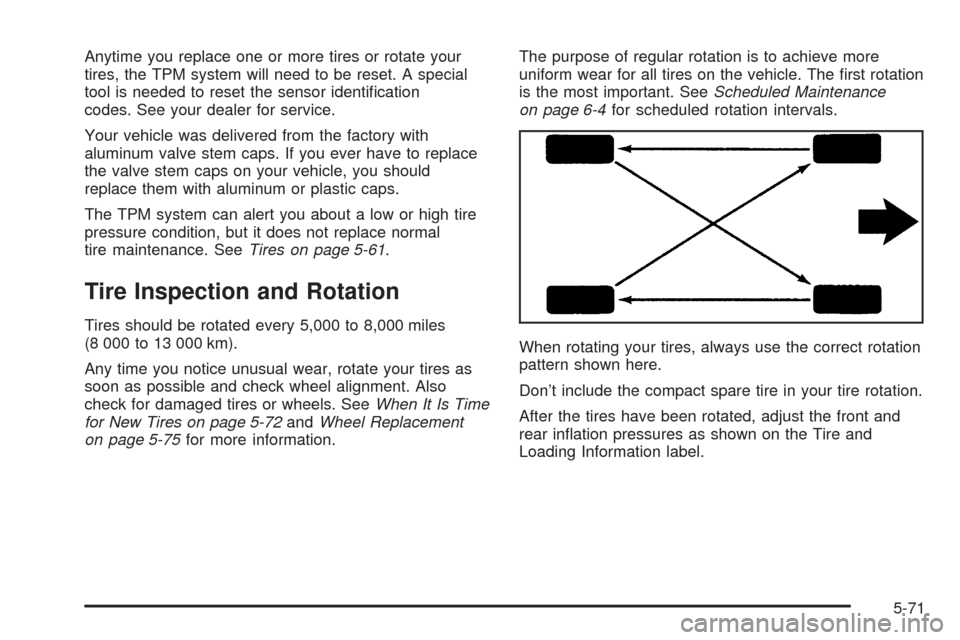
Anytime you replace one or more tires or rotate your
tires, the TPM system will need to be reset. A special
tool is needed to reset the sensor identification
codes. See your dealer for service.
Your vehicle was delivered from the factory with
aluminum valve stem caps. If you ever have to replace
the valve stem caps on your vehicle, you should
replace them with aluminum or plastic caps.
The TPM system can alert you about a low or high tire
pressure condition, but it does not replace normal
tire maintenance. SeeTires on page 5-61.
Tire Inspection and Rotation
Tires should be rotated every 5,000 to 8,000 miles
(8 000 to 13 000 km).
Any time you notice unusual wear, rotate your tires as
soon as possible and check wheel alignment. Also
check for damaged tires or wheels. SeeWhen It Is Time
for New Tires on page 5-72andWheel Replacement
on page 5-75for more information.The purpose of regular rotation is to achieve more
uniform wear for all tires on the vehicle. The first rotation
is the most important. SeeScheduled Maintenance
on page 6-4for scheduled rotation intervals.
When rotating your tires, always use the correct rotation
pattern shown here.
Don’t include the compact spare tire in your tire rotation.
After the tires have been rotated, adjust the front and
rear inflation pressures as shown on the Tire and
Loading Information label.
5-71
Page 333 of 410
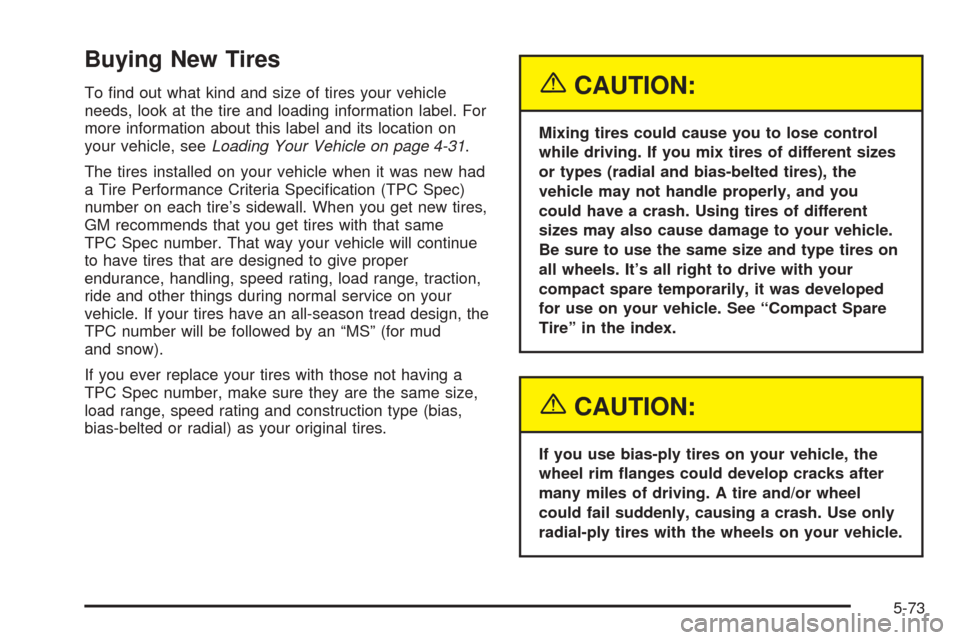
Buying New Tires
To find out what kind and size of tires your vehicle
needs, look at the tire and loading information label. For
more information about this label and its location on
your vehicle, seeLoading Your Vehicle on page 4-31.
The tires installed on your vehicle when it was new had
a Tire Performance Criteria Specification (TPC Spec)
number on each tire’s sidewall. When you get new tires,
GM recommends that you get tires with that same
TPC Spec number. That way your vehicle will continue
to have tires that are designed to give proper
endurance, handling, speed rating, load range, traction,
ride and other things during normal service on your
vehicle. If your tires have an all-season tread design, the
TPC number will be followed by an “MS” (for mud
and snow).
If you ever replace your tires with those not having a
TPC Spec number, make sure they are the same size,
load range, speed rating and construction type (bias,
bias-belted or radial) as your original tires.{CAUTION:
Mixing tires could cause you to lose control
while driving. If you mix tires of different sizes
or types (radial and bias-belted tires), the
vehicle may not handle properly, and you
could have a crash. Using tires of different
sizes may also cause damage to your vehicle.
Be sure to use the same size and type tires on
all wheels. It’s all right to drive with your
compact spare temporarily, it was developed
for use on your vehicle. See “Compact Spare
Tire” in the index.
{CAUTION:
If you use bias-ply tires on your vehicle, the
wheel rim flanges could develop cracks after
many miles of driving. A tire and/or wheel
could fail suddenly, causing a crash. Use only
radial-ply tires with the wheels on your vehicle.
5-73
Page 340 of 410
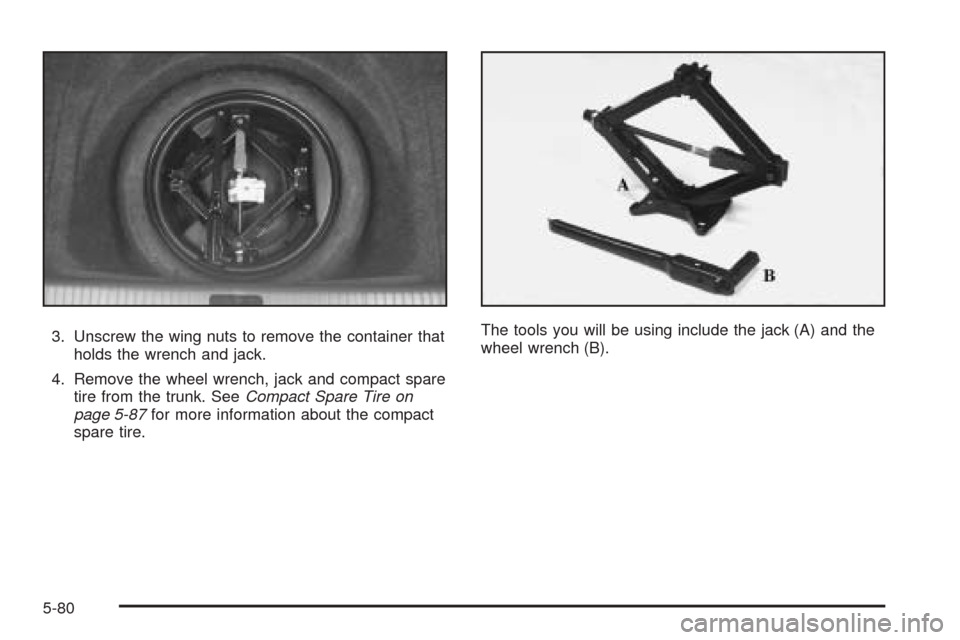
3. Unscrew the wing nuts to remove the container that
holds the wrench and jack.
4. Remove the wheel wrench, jack and compact spare
tire from the trunk. SeeCompact Spare Tire on
page 5-87for more information about the compact
spare tire.The tools you will be using include the jack (A) and the
wheel wrench (B).
5-80
Page 341 of 410
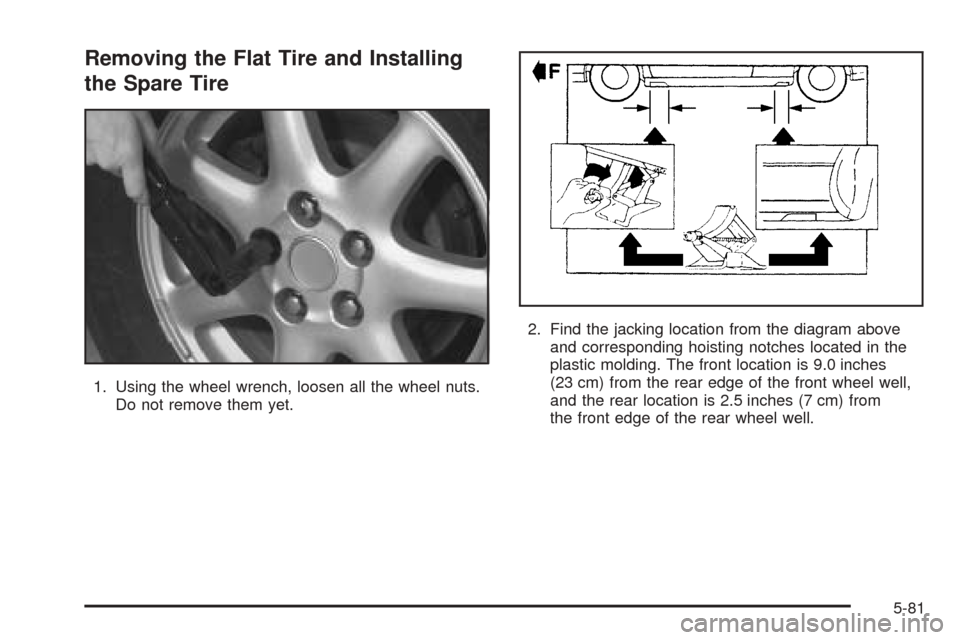
Removing the Flat Tire and Installing
the Spare Tire
1. Using the wheel wrench, loosen all the wheel nuts.
Do not remove them yet.2. Find the jacking location from the diagram above
and corresponding hoisting notches located in the
plastic molding. The front location is 9.0 inches
(23 cm) from the rear edge of the front wheel well,
and the rear location is 2.5 inches (7 cm) from
the front edge of the rear wheel well.
5-81
Page 342 of 410
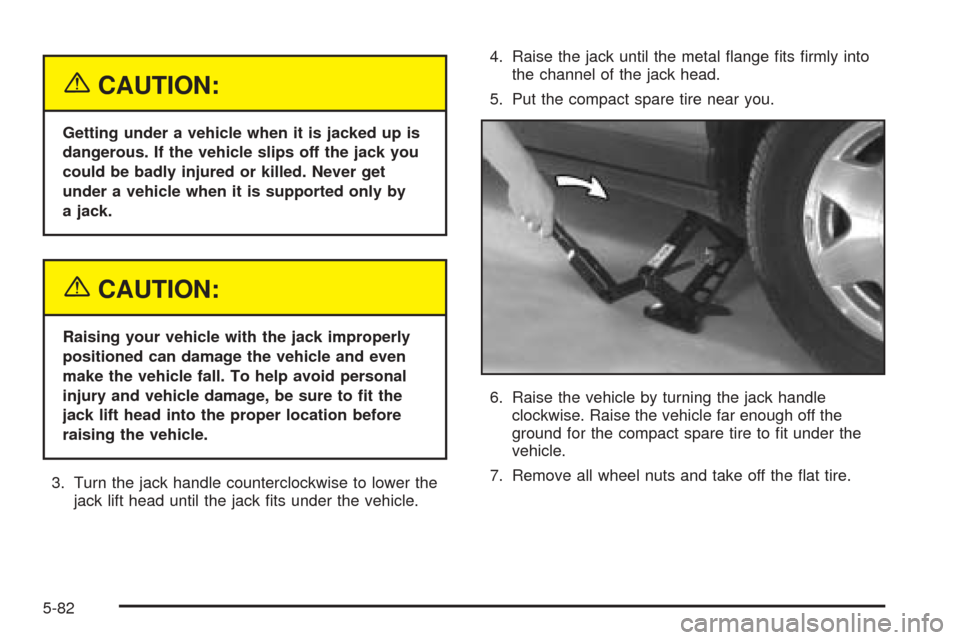
{CAUTION:
Getting under a vehicle when it is jacked up is
dangerous. If the vehicle slips off the jack you
could be badly injured or killed. Never get
under a vehicle when it is supported only by
a jack.
{CAUTION:
Raising your vehicle with the jack improperly
positioned can damage the vehicle and even
make the vehicle fall. To help avoid personal
injury and vehicle damage, be sure to fit the
jack lift head into the proper location before
raising the vehicle.
3. Turn the jack handle counterclockwise to lower the
jack lift head until the jack fits under the vehicle.4. Raise the jack until the metal flange fits firmly into
the channel of the jack head.
5. Put the compact spare tire near you.
6. Raise the vehicle by turning the jack handle
clockwise. Raise the vehicle far enough off the
ground for the compact spare tire to fit under the
vehicle.
7. Remove all wheel nuts and take off the flat tire.
5-82
Page 343 of 410
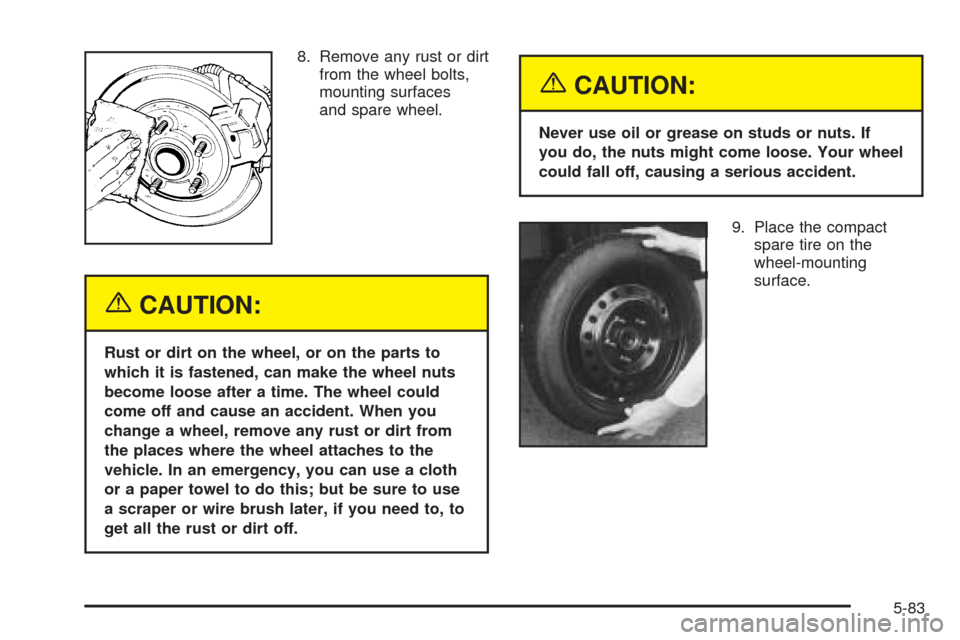
8. Remove any rust or dirt
from the wheel bolts,
mounting surfaces
and spare wheel.
{CAUTION:
Rust or dirt on the wheel, or on the parts to
which it is fastened, can make the wheel nuts
become loose after a time. The wheel could
come off and cause an accident. When you
change a wheel, remove any rust or dirt from
the places where the wheel attaches to the
vehicle. In an emergency, you can use a cloth
or a paper towel to do this; but be sure to use
a scraper or wire brush later, if you need to, to
get all the rust or dirt off.
{CAUTION:
Never use oil or grease on studs or nuts. If
you do, the nuts might come loose. Your wheel
could fall off, causing a serious accident.
9. Place the compact
spare tire on the
wheel-mounting
surface.
5-83
Page 345 of 410
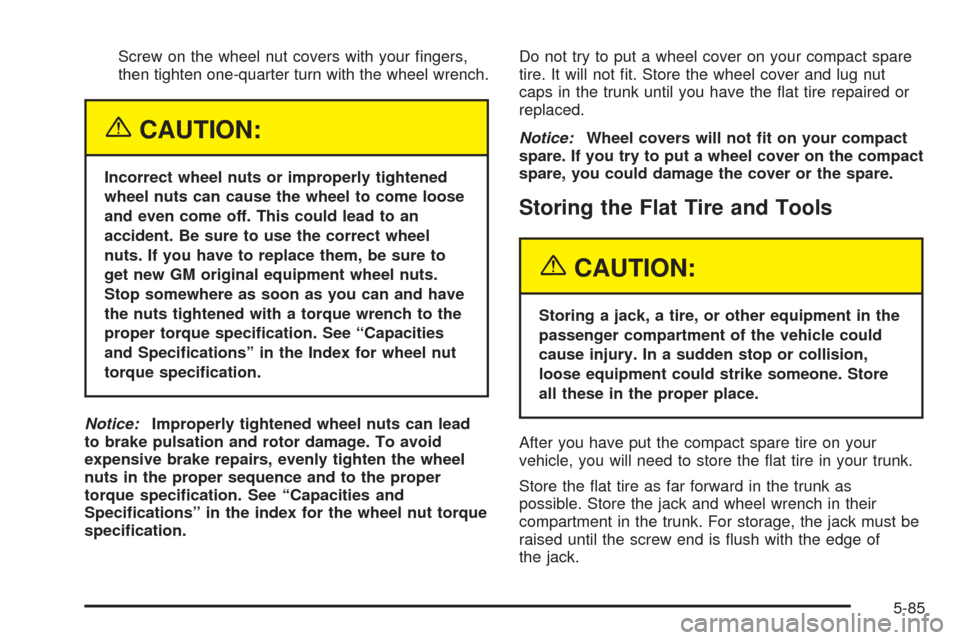
Screw on the wheel nut covers with your fingers,
then tighten one-quarter turn with the wheel wrench.
{CAUTION:
Incorrect wheel nuts or improperly tightened
wheel nuts can cause the wheel to come loose
and even come off. This could lead to an
accident. Be sure to use the correct wheel
nuts. If you have to replace them, be sure to
get new GM original equipment wheel nuts.
Stop somewhere as soon as you can and have
the nuts tightened with a torque wrench to the
proper torque specification. See “Capacities
and Specifications” in the Index for wheel nut
torque specification.
Notice:Improperly tightened wheel nuts can lead
to brake pulsation and rotor damage. To avoid
expensive brake repairs, evenly tighten the wheel
nuts in the proper sequence and to the proper
torque specification. See “Capacities and
Specifications” in the index for the wheel nut torque
specification.Do not try to put a wheel cover on your compact spare
tire. It will not fit. Store the wheel cover and lug nut
caps in the trunk until you have the flat tire repaired or
replaced.
Notice:Wheel covers will not fit on your compact
spare. If you try to put a wheel cover on the compact
spare, you could damage the cover or the spare.
Storing the Flat Tire and Tools
{CAUTION:
Storing a jack, a tire, or other equipment in the
passenger compartment of the vehicle could
cause injury. In a sudden stop or collision,
loose equipment could strike someone. Store
all these in the proper place.
After you have put the compact spare tire on your
vehicle, you will need to store the flat tire in your trunk.
Store the flat tire as far forward in the trunk as
possible. Store the jack and wheel wrench in their
compartment in the trunk. For storage, the jack must be
raised until the screw end is flush with the edge of
the jack.
5-85
Page 347 of 410
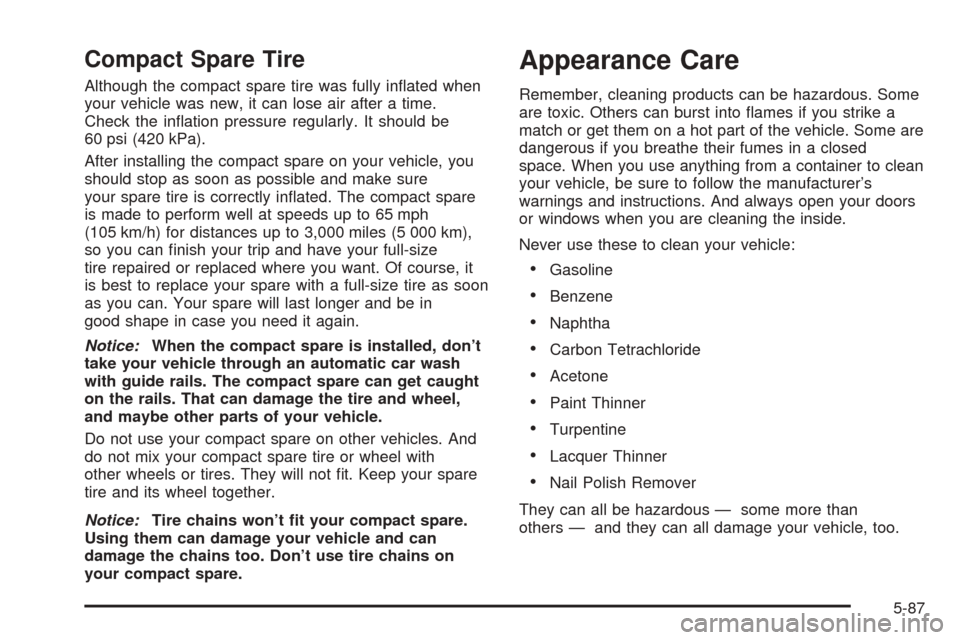
Compact Spare Tire
Although the compact spare tire was fully inflated when
your vehicle was new, it can lose air after a time.
Check the inflation pressure regularly. It should be
60 psi (420 kPa).
After installing the compact spare on your vehicle, you
should stop as soon as possible and make sure
your spare tire is correctly inflated. The compact spare
is made to perform well at speeds up to 65 mph
(105 km/h) for distances up to 3,000 miles (5 000 km),
so you can finish your trip and have your full-size
tire repaired or replaced where you want. Of course, it
is best to replace your spare with a full-size tire as soon
as you can. Your spare will last longer and be in
good shape in case you need it again.
Notice:When the compact spare is installed, don’t
take your vehicle through an automatic car wash
with guide rails. The compact spare can get caught
on the rails. That can damage the tire and wheel,
and maybe other parts of your vehicle.
Do not use your compact spare on other vehicles. And
do not mix your compact spare tire or wheel with
other wheels or tires. They will not fit. Keep your spare
tire and its wheel together.
Notice:Tire chains won’t fit your compact spare.
Using them can damage your vehicle and can
damage the chains too. Don’t use tire chains on
your compact spare.
Appearance Care
Remember, cleaning products can be hazardous. Some
are toxic. Others can burst into flames if you strike a
match or get them on a hot part of the vehicle. Some are
dangerous if you breathe their fumes in a closed
space. When you use anything from a container to clean
your vehicle, be sure to follow the manufacturer’s
warnings and instructions. And always open your doors
or windows when you are cleaning the inside.
Never use these to clean your vehicle:
•Gasoline
•Benzene
•Naphtha
•Carbon Tetrachloride
•Acetone
•Paint Thinner
•Turpentine
•Lacquer Thinner
•Nail Polish Remover
They can all be hazardous — some more than
others — and they can all damage your vehicle, too.
5-87
Page 397 of 410
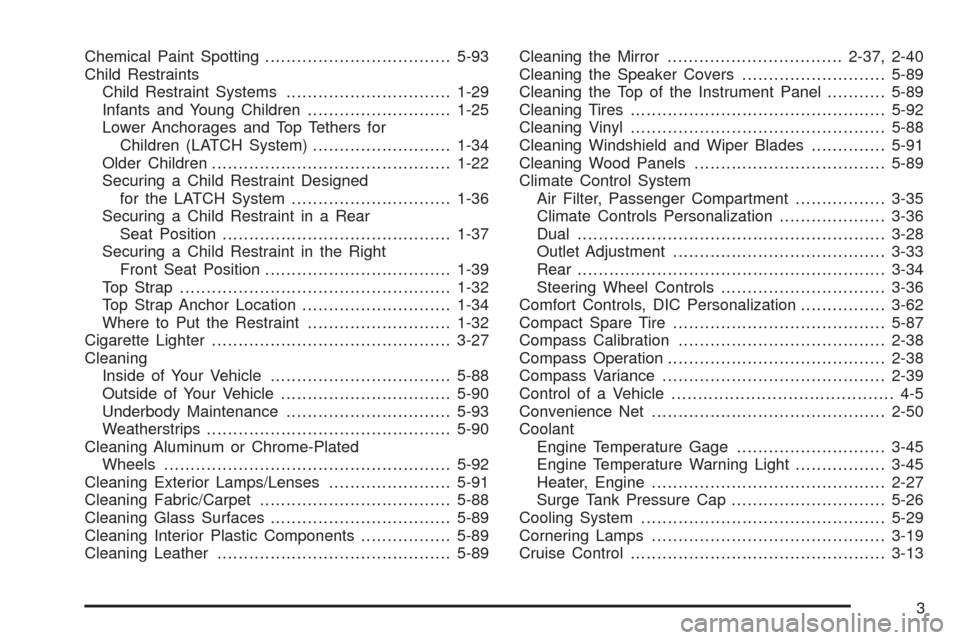
Chemical Paint Spotting...................................5-93
Child Restraints
Child Restraint Systems...............................1-29
Infants and Young Children...........................1-25
Lower Anchorages and Top Tethers for
Children (LATCH System)..........................1-34
Older Children.............................................1-22
Securing a Child Restraint Designed
for the LATCH System..............................1-36
Securing a Child Restraint in a Rear
Seat Position...........................................1-37
Securing a Child Restraint in the Right
Front Seat Position...................................1-39
Top Strap...................................................1-32
Top Strap Anchor Location............................1-34
Where to Put the Restraint...........................1-32
Cigarette Lighter.............................................3-27
Cleaning
Inside of Your Vehicle..................................5-88
Outside of Your Vehicle................................5-90
Underbody Maintenance...............................5-93
Weatherstrips..............................................5-90
Cleaning Aluminum or Chrome-Plated
Wheels......................................................5-92
Cleaning Exterior Lamps/Lenses.......................5-91
Cleaning Fabric/Carpet....................................5-88
Cleaning Glass Surfaces..................................5-89
Cleaning Interior Plastic Components.................5-89
Cleaning Leather............................................5-89Cleaning the Mirror.................................2-37, 2-40
Cleaning the Speaker Covers...........................5-89
Cleaning the Top of the Instrument Panel...........5-89
Cleaning Tires................................................5-92
Cleaning Vinyl................................................5-88
Cleaning Windshield and Wiper Blades..............5-91
Cleaning Wood Panels....................................5-89
Climate Control System
Air Filter, Passenger Compartment.................3-35
Climate Controls Personalization....................3-36
Dual..........................................................3-28
Outlet Adjustment........................................3-33
Rear..........................................................3-34
Steering Wheel Controls...............................3-36
Comfort Controls, DIC Personalization................3-62
Compact Spare Tire........................................5-87
Compass Calibration.......................................2-38
Compass Operation.........................................2-38
Compass Variance..........................................2-39
Control of a Vehicle.......................................... 4-5
Convenience Net............................................2-50
Coolant
Engine Temperature Gage............................3-45
Engine Temperature Warning Light.................3-45
Heater, Engine............................................2-27
Surge Tank Pressure Cap.............................5-26
Cooling System..............................................5-29
Cornering Lamps............................................3-19
Cruise Control................................................3-13
3